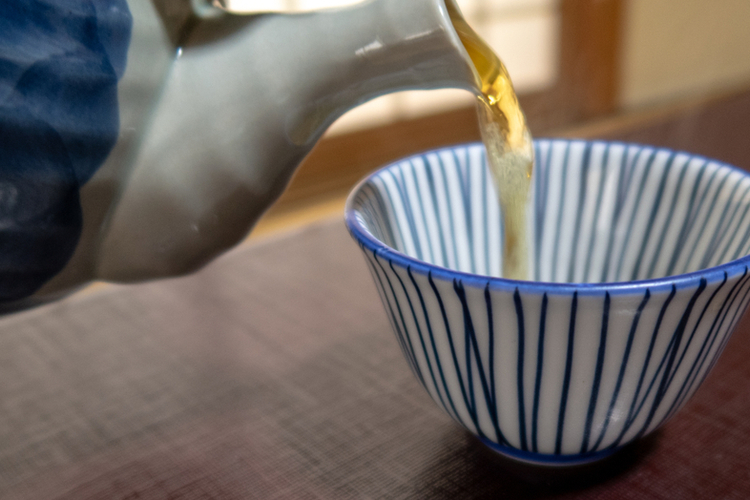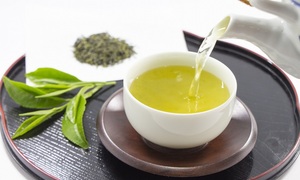Japanese tea has various types such as Sencha, Gkyokuro, Hojicha, and Genmaicha.
The manner of making tea is very important to maximize the taste of each tea.
Basic tea making has the standards verified by Tea Making Study Group and Tea Industry related associations in Japan.
Please enjoy the tastes of Japanese tea with learning the tips for making tea.

Common Tips for Japanese Tea Making
To make Japanese tea, the best temperature of hot water differs from an amount and a type, but the process is basically the same.
Let’s see the common tips of making Japanese tea from 3 points; “water”, “process” and “pouring”.
W ater to be Boiled
Soft water is suitable for Japanese tea. Hard water does not bring a color and a scent of tea, and may change its taste.
Tap water in Japan is soft water, which is suitable for tea, but has chlorine odor because of chlorination.
It is possible to remove its chlorine odor by boiling water for 3-5 minutes.
When you use bottled water, you should be careful to choose soft water, not hard one.
Boiled water needs to be cooled down to the best temperature for making each tea.
The temperature of hot water drops around 5-10℃ each time hot water is poured to a vessel.
It can be adjusted by pouring water to “Yusamashi”, which refers to teaware to adjust the water temperature, a teapot, or a teacup.
Please do not use tap water without boiling to cut corners knowing it will get cooled down later!
Boiling works not only to remove chlorine odor, but to sterilize and step more tea components.
P rocess of Making Tea
The basic process of making Japanese tea is as follows.
Please refer to the following sections about an amount of tea leaves, hot water temperature, an amount of water, infusing time, suitable teaware, for each type of tea.
1. Boil water once, then cool it down to the appropriate temperature by pouring to Yusamashi or a teacup.
Amount of hot water is around 80% of a teacup.
Cooling down in a teacup warms a teacup itself and does scaling amount of hot water.
At the 1st infusing, tea leaves absorb hot water, so it is better to put more hot water.
2. Measure an amount of tea leaves and put it into a teapot.
When you use a teaspoon, recommended amount for Futsu-Sencha (regular Sencha) is around 2g for a light rounded teaspoon, around 3g for a full rounded teaspoon.
Premium tea is a bit heavier than regular Sencha, and Hojicha is light but bulky, which weighs around 1g on a teaspoon.
3. Pour hot water of the appropriate temperature to Kyusu (a teapot) slowly, and have tea leaves infuse with a lid on.
4. Pour from Kyusu to Chawan (a teacup) little by “Mawashi-Sosogi (pouring little by little)” and serve it putting Chawan on Chataku (a tea saucer).
P our Japanese Tea by “Mawashi-Sosogi”
It is ideal to make every teacup have the same amount of tea with the same strength.
“Mawashi-Sosogi”, literally meaning “pouring around”, suits to make Japanese tea perfect.
This is the manner of pouring to repeat pouring all Chawan little by little in order.
Japanese tea inside Kyusu has to be poured off till the very last drop.
Any hot water left in Kyusu keep infusing tea, which ruins the taste at the 2nd infusing.
At the 2nd infusing, higher temperature of hot water than that of the 1st makes the infusion more strongly, which takes a half of the 1st infusing time.

Appropriate Pouring Manners for Each Japanese Tea
Each Japanese tea has each appropriate amount of tea leaves, hot water temperature, an amount of hot water, infusing time, teaware, by its type.
Here, we introduce amount and size of teaware to serve 3 people.
To serve for one, it is good to put more tea leaves, then you can enjoy the 2nd brewing.
Kyusu (a teapot) with enough size to have moderate space between a lid and the surface of hot water, makes hot water and tea leaves circulate better, and has stronger infusion to make Japanese tea with good taste.
S encha / Gyokuryokucha
Each grade of Sencha has different appropriate temperature and size of teaware.
There are no rules for it, but for serving your guests “upper grade” and for yourself “regular grade’ are normally used.
For upper grade tea, a smaller size of teaware makes it better to keep its scent and taste.
Gyokuryokucha can be made beautifully with the same manner as that for Sencha.
・Size of Teaware
Upper graded Sencha: Kyusu 250ml, Chawan 100ml
Regular graded Sencha: Kyusu 600ml, Chawan 150ml
・Amount of Tea leaves
For both the upper and the regular, 6-9g for 3 people (2-3g per person)
・Hot water temperature and Infusing time
Upper graded Sencha: 2 minutes under around 70 degrees
Regular graded Sencha: 1 minute under around 80-90 degrees
F ukamushi Sencha (deeply steamed Sencha)
Compared with Sencha, Fukamushi Sencha takes shorter infusing time.
It is steamed longer on producing, which makes tea leaves more fragile and finer to have it infused in a shorter time.
Since tea leaves of Fukamushi Sencha are fine, they sometimes clog up with Kyusu for Sencha not to pour off.
It is recommended to use Kyusu for Fukamushi Sencha with mesh net for clogging prevention.
・Size of Teaware
Kyusu 360-550ml, Chawan 100-150ml
・Amount of Tea leaves
6g for 3 people (2g per person)
・Hot water temperature and Infusing time
30 seconds under around 80-90 degrees
At the 2nd infusing, no need to have infusing time
G yokuro
Gyokuro is the representative of premium Japanese tea, which you enjoy the small amount while taking the time.
Infusing tea leaves with a small amount of hot water changes its taste by each time.
You can enjoy deep and sweet taste at the 1st infusing, mild taste at the 2nd and 3rd, Sencha-like taste at the 4th.
・Size of Teaware
Kyusu 90ml, Chawan 40ml
・Amount of Tea leaves
9g for 3 people (3g per person)
・Hot water temperature and Infusing time
Upper graded (at the 1st infusing): 2 minutes and a half under around 50 degrees
Regular graded (at the 1st infusing): around 2 minute under around 60 degrees
At the 2nd and 3rd infusing, raise the hot water temperature 5-10 degrees by each time gradually and shorten infusing time to around 30 seconds at the 2nd and around 15 seconds at the 3rd.
At the 4th, pour around 80 degrees of hot water.
H ojicha / Bancha / Genmaicha
Hojicha, Bancha, and Genmaicha with simple tastes have less flavor, but you can enjoy its scents.
It is recommended to use a cylindrical Yunomi (a teacup) thick and big to pour a plenty of very hot water.
・Size of Teaware
Kyusu or Dobin (earthenware teapot) 800ml, Chawan 200ml
・Amount of Tea leaves
9g for 3 people (3g per person)
・Hot water temperature and Infusing time
around 30 seconds under boiling hot water
At the 2nd, no need to have infusing time, which is the last for tea leaves taste

M izudashicha (water infused tea), Reicha (cold tea)
A hot summer day makes you want some cold tea, doesn’t it?
Sencha, Fukamushi Sencha, and Gyokuryokucha are suitable for water infusing or the cold.
Especially, Fukamushi Sencha has fine tea leaves, which works best for water infusing.
・How to make Mizudashicha
1. Cool down boiled tap water
2. Put tea leaves to Kyusu. The amout of it is a bit more than usual.
3. Pour cooled water to Kyusu slowly to infuse for around 5-15 minutes.
4. Pour tea by Mawashi-Susugi to Chawan or a glass.
You can also make a large amount of tea to have some days by a cold-water kettle.
1. Cool down boiled tap water
2. Put 10-15g tea leaves in a tea bag per 1 liter of water
3. Put the tea bag and water in a cold water kettle
4. Rest it for around 1 hour
・How to make cold tea
1. Make strong tea in Kyusu
2. Pour the tea to a glass or Chawan with ice

Let’s Make Japanese tea as You like!
There are many manners to make Japanese tea, not only the ones introduced above.
The same type tea can make each different feature by the process of producing and finishing.
Beginning with the basic manner, you can find a new taste by adjusting to meet your preference.
Moreover, tea-ware will change its size and type depending on occasions where you have Japanese tea.
Above all, the most important thing is you enjoy tasting Japanese tea.
Let’s find your own manner to make the best Japanese tea for yourself.








